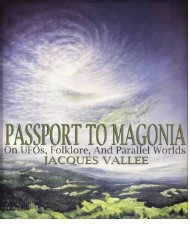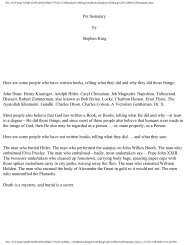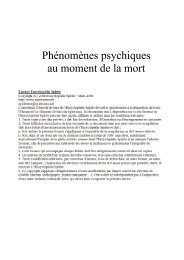extraordinary%20encounters
extraordinary%20encounters
extraordinary%20encounters
You also want an ePaper? Increase the reach of your titles
YUMPU automatically turns print PDFs into web optimized ePapers that Google loves.
walk. Three crew members stepped outside,<br />
two to work on the structure, the third to chat<br />
with the witness. The stranger told Williams<br />
that he had built the ship after many years of<br />
experiment and error “at a little town in the<br />
interior of New York.”<br />
The May 16 issue of the same newspaper<br />
carried a letter forwarded by Dr. D. H.<br />
Tucker. Tucker said that a young man who<br />
subsequently drowned in a flood in Mississippi<br />
had written the original, recounting an<br />
experience that occurred on April 19 in the<br />
Lake Charles, Louisiana, area. While riding in<br />
his buggy, he spotted an airship approaching.<br />
A high-pitched whistle from the vessel<br />
spooked his horses, and he was thrown to the<br />
ground. When the ship landed, two men<br />
rushed from it to help him to his feet and to<br />
extend their apologies. One introduced himself<br />
as “Mr. Wilson,” though the witness<br />
doubted that was his real name. Wilson stated<br />
that he and his companion, Scott Warren, had<br />
invented a fleet of ships. They were now seeking<br />
to demonstrate that long-distance airship<br />
travel was safe and economical. The young<br />
man was invited to tour the vehicle, where he<br />
met two other crew members.<br />
That same day, at around 11 P.M., at Beaumont,<br />
Texas, according to an account published<br />
in the Houston Daily Post of April 21,<br />
lights in a neighbor’s pasture caught the eyes<br />
of J. R. Ligon and his son Charley. They observed<br />
“four men moving around a large dark<br />
object” that they recognized, as they approached<br />
it, as an airship. Its crew asked for<br />
water and accompanied the two to the house,<br />
where they filled their buckets. “I accosted<br />
one of the men,” the elder Ligon reported,<br />
“and he told me his name was Wilson. . . .<br />
They were returning from a trip out on the<br />
Gulf and were now headed toward Iowa,<br />
where the airship was built.” It was one of five<br />
that had been constructed there. The Ligons<br />
accompanied them back to the ship, a huge<br />
structure 136 feet long and 20 feet wide, with<br />
four large wings and propellers attached to<br />
bow and stern. Wilson explained it was powered<br />
by “electricity.”<br />
Wilson 271<br />
On April 25 the New Orleans Daily Pi c a -<br />
y u n e carried an interv i ew with a visitor, Rabbi<br />
A. Levy of Beaumont. Levi recalled that “a b o u t<br />
10 days ago,” on hearing that an airship had<br />
landed late that night on a farm just outside<br />
t own, he hastened to the site. T h e re sat an airship<br />
some 150 feet long with 100-foot wings.<br />
“I spoke to one of the men when he went into<br />
the farmer’s house, and shook hands with<br />
him,” Levy claimed. “Yes, I did hear him say<br />
w h e re it was built, but I can’t remember the<br />
name of the place, or the name of the inve n t o r.<br />
He said that they had been traveling a gre a t<br />
deal, and we re testing the machine. I was do<br />
dumbfounded that I could not frame an intelligent<br />
question to ask.” He did re m e m b e r,<br />
though, that “e l e c t r i c i t y” powe red the craft.<br />
At Uvalde, three hundred miles southwe s t<br />
of Beaumont, twe n t y - t h ree hours after the<br />
L i g o n s’s alleged encounter, Sheriff H. W. Ba ylor<br />
witnessed an airship landing near his home.<br />
Baylor saw three crew members and spoke<br />
with one, a Mr. Wilson, a native of Go s h e n ,<br />
New Yo rk. The aeronaut recalled an old friend,<br />
Captain C. C. Akers, whom he said he had<br />
k n own in Fo rt Wo rth. Now, he understood,<br />
Akers lived in the area. Baylor replied that he<br />
k n ew Akers, who was employed as a customs<br />
officer in Eagle Pass but who frequently visited<br />
Uvalde. After asking the sheriff to give his best<br />
to Akers, Wilson and his crew flew away. T h e<br />
Houston Daily Po s t , which re p o rted the story<br />
in its April 21 issue, mentioned the sighting,<br />
the same night as Ba y l o r’s alleged encounter<br />
with Wilson, of an airship passing just nort h<br />
of the Baylor residence. Contacted by the Ga l -<br />
veston Daily Ne w s ( April 28), Akers confir m e d<br />
that twenty years earlier he had known “a man<br />
by the name of Wilson from New Yo rk<br />
s t a t e . . . . He was of a mechanical turn of mind<br />
and was then working on aerial navigation and<br />
something that would astonish the world.”<br />
At midnight on April 22, east of Josserand<br />
(seventy-five miles northwest of Beaumont), a<br />
“whirring noise” awoke farmer Frank Nichols,<br />
according to the Houston Daily Post (April<br />
26). On investigating, he spotted a large, brilliantly<br />
lighted airship in his cornfield. Two





